Afficher/cacher Sommaire

OVH KVM OpenStack vps506197 (1 vCore 2.4Ghz/4Go Ram/20Go SSD/Local Raid10/Strasbourg)
Noyau, réseau et domaine

Debian Buster
PARAMETRES D’ACCES:
L’adresse IPv4 du VPS est : 164.132.104.145
L’adresse IPv6 du VPS est : 2001:41d0:0401:3200::06e7
Le nom du VPS est : vps506197.ovh.net
Connexion SSH en “root” ( H2eHmVmw )
ssh root@164.132.104.145
Installer noyau 5.6+
Le noyau 5.6 a le module wireguard intégré
echo "deb http://deb.debian.org/debian/ unstable main" | sudo tee /etc/apt/sources.list.d/unstable-wireguard.list
printf 'Package: *\nPin: release a=unstable\nPin-Priority: 90\n' | sudo tee /etc/apt/preferences.d/limit-unstable
apt update && apt upgrade
apt install linux-image-5.6.0-2-cloud-amd64
Réseau
Créer un bash pour désactiver l’initialisation réseau par le cloud sur le VPS OVH
nano initres.sh
#!/bin/bash
#
# To disable cloud-init's network configuration capabilities, write a file
# /etc/cloud/cloud.cfg.d/99-disable-network-config.cfg with the following:
# network: {config: disabled}
#
#Création du fichier **/etc/cloud/cloud.cfg.d/99-disable-network-config.cfg** en mode su
echo "network: {config: disabled}" > /etc/cloud/cloud.cfg.d/99-disable-network-config.cfg
#
# Effacerle fichier /etc/network/interfaces
rm /etc/network/interfaces
# Recréer le fichier /etc/network/interfaces
cat > /etc/network/interfaces << EOF
auto lo
iface lo inet loopback
auto eth0
iface eth0 inet dhcp
iface eth0 inet6 static
address 2001:41d0:0401:3200::06e7
netmask 128
post-up /sbin/ip -6 route add 2001:41d0:0401:3200::1 dev eth0
post-up /sbin/ip -6 route add default via 2001:41d0:0401:3200::1 dev eth0
pre-down /sbin/ip -6 route del default via 2001:41d0:0401:3200::1 dev eth0
pre-down /sbin/ip -6 route del 2001:41d0:0401:3200::1 dev eth0
EOF
#
# Configuration OVH à modifier /etc/cloud/cloud.cfg
sed -i 's/preserve_hostname: false/preserve_hostname: true/g' /etc/cloud/cloud.cfg
sed -i 's/manage_etc_hosts: true/manage_etc_hosts: false/g' /etc/cloud/cloud.cfg
#
# Redémarrage de la machine
systemctl reboot
Droits et exécution
chmod +x initres.sh && ./initres.sh
Patienter quelques minutes avant la reconnexion…
Se connecter en root via SSH
ssh root@164.132.104.145
Vérifier le réseau ip a et noyau uname -r
1: lo: <LOOPBACK,UP,LOWER_UP> mtu 65536 qdisc noqueue state UNKNOWN group default qlen 1000
link/loopback 00:00:00:00:00:00 brd 00:00:00:00:00:00
inet 127.0.0.1/8 scope host lo
valid_lft forever preferred_lft forever
inet6 ::1/128 scope host
valid_lft forever preferred_lft forever
2: eth0: <BROADCAST,MULTICAST,UP,LOWER_UP> mtu 1500 qdisc pfifo_fast state UP group default qlen 1000
link/ether fa:16:3e:f1:2a:30 brd ff:ff:ff:ff:ff:ff
inet 164.132.104.145/32 brd 164.132.104.145 scope global dynamic eth0
valid_lft 86295sec preferred_lft 86295sec
inet6 2001:41d0:401:3200::6e7/128 scope global
valid_lft forever preferred_lft forever
inet6 fe80::f816:3eff:fef1:2a30/64 scope link
valid_lft forever preferred_lft forever
Noyau 5.6.0-2-cloud-amd64
Locales fr UTF8 : dpkg-reconfigure locales
Fuseau Europe/Paris : dpkg-reconfigure tzdata
domaine cinay.eu

Zone dns OVH
Si vous utilisez des sous-domaines de type xxx.cinay.eu , vous devez renseigner chaque sous-domaine avec la directive CNAME
Liste des sous-domaines (septembre 2020)
div.cinay.eu
gitea.cinay.eu
static.cinay.eu
wg.cinay.eu
zic.cinay.eu
$TTL 3600
@ IN SOA dns100.ovh.net. tech.ovh.net. (2020102803 86400 3600 3600000 300)
IN NS ns100.ovh.net.
IN NS dns100.ovh.net.
IN MX 10 cinay.eu.
IN A 164.132.104.145
IN AAAA 2001:41d0:401:3200::6e7
IN CAA 128 issue "letsencrypt.org"
600 IN TXT "v=spf1 a mx -all"
_dmarc IN TXT "v=DMARC1;p=none;"
_xmpp-client._tcp IN SRV 0 5 5222 cinay.eu.
_xmpp-server._tcp IN SRV 0 5 5269 cinay.eu.
mail._domainkey IN TXT ( "v=DKIM1;h=sha256;k=rsa;p=MIGfMA0GCSqGSIb3DQEBAQUAA4GNADCBiQKBgQDPZWCRYepm2ZXYhqkoJQSmKMBGrhKh08WVBfdMJD7mqKV3j8oNP1uLm9GVzVidFwyGnEntVrJJKajvHDwCQYFgWzA7y32VxYh74P0vEP6OzOjnCX0/57vp+Wjcxcc5pRAWCYFvUvIC55U0ows5zfdGYiA/ey8Toe68WOrd0YYubQIDAQAB;" )
muc IN CNAME cinay.eu.
pubsub IN CNAME cinay.eu.
vjud IN CNAME cinay.eu.
xmpp-upload IN CNAME cinay.eu.
div IN CNAME cinay.eu.
gitea IN CNAME cinay.eu.
static IN CNAME cinay.eu.
wg IN CNAME cinay.eu.
zic IN CNAME cinay.eu.
yanfi IN CNAME login.tutanota.com.
Reverse DNS sur “server” , IP 164.132.104.145 → cinay.eu
Reverse DNS sur “server” , 2001:41d0:401:3200::6e7 → cinay.eu
Test reverse DNS : dig -x 164.132.104.145 et dig -x 2001:41d0:401:3200:0:0:0:6e7
Hostname
hostnamectl set-hostname cinay.eu
hostnamectl
Static hostname: cinay.eu
Icon name: computer-vm
Chassis: vm
Machine ID: 0ef30511d74646618d92e464efb187ce
Boot ID: 8c555dba579c417088eb060960c3c238
Virtualization: kvm
Operating System: Debian GNU/Linux 10 (buster)
Kernel: Linux 5.6.0-2-cloud-amd64
Architecture: x86-64
Yunohost
Alpha-stage testing for YunoHost 4.0 on Debian Buster (and migration shipped in Yunohost 3.8.5)

Installation
apt install curl
curl https://raw.githubusercontent.com/YunoHost/install_script/buster-unstable/install_yunohost | bash
Patienter…
[ OK ] YunoHost installation completed !
===============================================================================
You should now proceed with Yunohost post-installation. This is where you will
be asked for :
- the main domain of your server ;
- the administration password.
You can perform this step :
- from the command line, by running 'yunohost tools postinstall' as root
- or from your web browser, by accessing :
- https://164.132.104.145/ (global IP, if you're on a VPS)
If this is your first time with YunoHost, it is strongly recommended to take
time to read the administator documentation and in particular the sections
'Finalizing your setup' and 'Getting to know YunoHost'. It is available at
the following URL : https://yunohost.org/admindoc
===============================================================================
Post-installation
yunohost tools postinstall
Success! YunoHost is now configured
Warning: The post-install completed! To finalize your setup, please consider:
- adding a first user through the 'Users' section of the webadmin (or 'yunohost user create <username>' in command-line);
- diagnose potential issues through the 'Diagnosis' section of the webadmin (or 'yunohost diagnosis run' in command-line);
- reading the 'Finalizing your setup' and 'Getting to know Yunohost' parts in the admin documentation: https://yunohost.org/admindoc.
Créer un utilisateur (yunohost)
yunohost user create yann
First name: yann
Last name: cinayeu
E-mail address: yann@cinay.eu
You are now about to define a new user password. The password should be at least 8 characters long—though it is good practice to use a longer password (i.e. a passphrase) and/or to a variation of characters (uppercase, lowercase, digits and special characters).
Password:
Confirm password:
Success! User created
fullname: yann cinayeu
mail: yann@cinay.eu
username: yann
Administration
Configuration DNS
; Basic ipv4/ipv6 records
@ 3600 IN A 164.132.104.145
@ 3600 IN AAAA 2001:41d0:401:3200::6e7
; XMPP
_xmpp-client._tcp 3600 IN SRV 0 5 5222 cinay.eu.
_xmpp-server._tcp 3600 IN SRV 0 5 5269 cinay.eu.
muc 3600 IN CNAME @
pubsub 3600 IN CNAME @
vjud 3600 IN CNAME @
xmpp-upload 3600 IN CNAME @
; Mail
@ 3600 IN MX 10 cinay.eu.
@ 3600 IN TXT "v=spf1 a mx -all"
mail._domainkey 3600 IN TXT "v=DKIM1; h=sha256; k=rsa; p=MIGfMA0GCSqGSIb3DQEBAQUAA4GNADCBiQKBgQDPZWCRYepm2ZXYhqkoJQSmKMBGrhKh08WVBfdMJD7mqKV3j8oNP1uLm9GVzVidFwyGnEntVrJJKajvHDwCQYFgWzA7y32VxYh74P0vEP6OzOjnCX0/57vp+Wjcxcc5pRAWCYFvUvIC55U0ows5zfdGYiA/ey8Toe68WOrd0YYubQIDAQAB"
_dmarc 3600 IN TXT "v=DMARC1; p=none"
; Extra
* 3600 IN A 164.132.104.145
* 3600 IN AAAA 2001:41d0:401:3200::6e7
@ 3600 IN CAA 128 issue "letsencrypt.org"
Certificats SSL
Installer un certificat Let’s Encrypt en ligne de commande
yunohost domain cert-install --no-checks
Info: Now attempting install of certificate for domain cinay.eu!
Success! Configuration updated for 'dnsmasq'
Warning: No diagnosis cache yet for category 'dnsrecords'
Warning: Subdomain 'xmpp-upload.cinay.eu' does not resolve to the same IP address as 'cinay.eu'. Some features will not be available until you fix this and regenerate the certificate.
Info: Parsing account key...
Info: Parsing CSR...
Info: Found domains: cinay.eu
Info: Getting directory...
Info: Directory found!
Info: Registering account...
Info: Registered!
Info: Creating new order...
Info: Order created!
Info: Verifying cinay.eu...
Info: cinay.eu verified!
Info: Signing certificate...
Info: Certificate signed!
Success! Configuration updated for 'nginx'
Success! Let's Encrypt certificate now installed for the domain 'cinay.eu'
Utilisateur “debian”
Modifier le mot de passe de l’utilisateur existant debian
passwd debian
Visudo pour les accès root via utilisateur debian
echo "debian ALL=(ALL) NOPASSWD: ALL" >> /etc/sudoers
Changer le mot de passe root
passwd root
Historique de la ligne de commande
Ajoutez la recherche d’historique de la ligne de commande au terminal. Tapez un début de commande précédent, puis utilisez shift + up (flèche haut) pour rechercher l’historique filtré avec le début de la commande.
# Global, tout utilisateur
echo '"\e[1;2A": history-search-backward' | sudo tee -a /etc/inputrc
echo '"\e[1;2B": history-search-forward' | sudo tee -a /etc/inputrc
exit
OpenSSH, clé et script

connexion avec clé
sur l'ordinateur de bureau
Générer une paire de clé curve25519-sha256 (ECDH avec Curve25519 et SHA2) nommé kvm-cinay pour une liaison SSH avec le serveur KVM.
ssh-keygen -t ed25519 -o -a 100 -f ~/.ssh/kvm-vps506197
Envoyer la clé publique sur le serveur KVM
scp ~/.ssh/kvm-vps506197.pub debian@164.132.104.145:/home/debian/
sur le serveur KVM On se connecte
ssh debian@164.132.104.145
Copier le contenu de la clé publique dans /home/$USER/.ssh/authorized_keys
cd ~
Sur le KVM ,créer un dossier .ssh
mkdir .ssh
cat $HOME/kvm-vps506197.pub >> $HOME/.ssh/authorized_keys
et donner les droits
chmod 600 $HOME/.ssh/authorized_keys
effacer le fichier de la clé
rm $HOME/kvm-vps506197.pub
Modifier la configuration serveur SSH
sudo nano /etc/ssh/sshd_config # attention aux 2 dernières lignes
Modifier
Port 55034
PasswordAuthentication no # avant dernière ligne
PermitRootLogin no # dernière ligne
session SSH ne se termine pas correctement lors d'un "reboot" à distance
Si vous tentez de redémarrer/éteindre une machine distance par ssh, vous pourriez constater que votre session ne se termine pas correctement, vous laissant avec un terminal inactif jusqu’à l’expiration d’un long délai d’inactivité. Il existe un bogue 751636 à ce sujet. Pour l’instant, la solution de contournement à ce problème est d’installer :
sudo apt install libpam-systemd # installé par défaut sur debian buster
cela terminera la session ssh avant que le réseau ne tombe.
Veuillez noter qu’il est nécessaire que PAM soit activé dans sshd.
Relancer openSSH
sudo systemctl restart sshd
Ouvrir le port 55034 et fermer le port 22
sudo yunohost firewall allow TCP 55034
sudo yunohost firewall disallow TCP 22
Accès depuis le poste distant avec la clé privée
ssh -p 55034 -i ~/.ssh/kvm-vps506197 debian@164.132.104.145
Outils, scripts motd et ssh_rc_bash
Installer utilitaires
sudo apt install rsync curl tmux jq figlet git dnsutils tree -y
Motd
sudo rm /etc/motd && sudo nano /etc/motd
___ __ __ _ ___ ____
__ __ _ __ ___| __| / \ / / / |/ _ \|__ |
\ V /| '_ \(_-<|__ \| () |/ _ \| |\_, / / /
\_/ | .__//__/|___/ \__/ \___/|_| /_/ /_/
|_|
__ (_) _ _ __ _ _ _ ___ _ _
/ _|| || ' \ / _` || || | _ / -_)| || |
\__||_||_||_|\__,_| \_, |(_)\___| \_,_|
|__/
Script ssh_rc_bash
ATTENTION!!! Les scripts sur connexion peuvent poser des problèmes pour des appels externes autres que ssh
wget https://static.xoyaz.xyz/files/ssh_rc_bash
chmod +x ssh_rc_bash # rendre le bash exécutable
./ssh_rc_bash # exécution
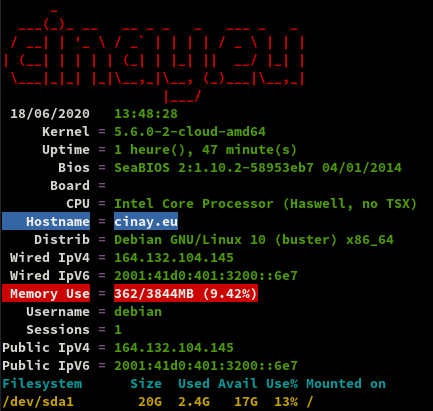
Domaine yanfi.net
DNS OVH yanfi.net géré par le serveur cinay.eu
Remplacer 51.75.120.106 → 164.132.104.145
Remplacer 2001:41d0:305:2100::4dc0 → 2001:41d0:401:3200::6e7
Administration Yunohost → ajout domaine yanfi.net
Domaine yanfi.net Configuration DNS et ajuster le domaine yanfi.net sur OVH
$TTL 3600
@ IN SOA dns110.ovh.net. tech.ovh.net. (2020072800 86400 3600 3600000 300)
IN NS dns110.ovh.net.
IN NS ns110.ovh.net.
IN MX 10 yanfi.net.
IN A 164.132.104.145
IN AAAA 2001:41d0:401:3200::6e7
IN CAA 128 issue "letsencrypt.org"
600 IN TXT "v=spf1 a mx -all"
* IN CNAME yanfi.net.
_dmarc IN TXT "v=DMARC1; p=none"
_xmpp-client._tcp IN SRV 0 5 5222 yanfi.net.
_xmpp-server._tcp IN SRV 0 5 5269 yanfi.net.
mail._domainkey IN TXT ( "v=DKIM1;h=sha256;k=rsa;p=MIGfMA0GQ.......IDAQAB;" )
muc IN CNAME yanfi.net.
pubsub IN CNAME yanfi.net.
vjud IN CNAME yanfi.net.
xmpp-upload IN CNAME yanfi.net.
Certificats en ligne de commande : yunohost domain cert-install yanfi.net --no-checks
Paramétrage de la messagerie :
Thunderbird , il faut passer par les serveurs IMAP et SMTP cinay.eu
k-9mail android , il faut passer par les serveurs IMAP et SMTP yanfi.net
Go Node Python
Go
![]()
Go installation (Debian) , installer la dernière version de Go (https://golang.org/dl/)
cd ~
wget https://golang.org/dl/go1.15.3.linux-amd64.tar.gz
sudo tar -C /usr/local -xzf go1.15.3.linux-amd64.tar.gz
rm go1.15.3.linux-amd64.tar.gz
Environnement de configuration
Bash: ~/.bashrc
mkdir -p $HOME/go
echo "export PATH=$PATH:/usr/local/go/bin:$HOME/go/bin" >> ~/.bashrc
echo "export GOPATH=$HOME/go" >> ~/.bashrc
source ~/.bashrc
Nodejs

Installer la version LTS de nodejs pour le frontend.
sudo apt-get install curl software-properties-common -y
curl -sL https://deb.nodesource.com/setup_14.x | sudo bash -
## Run `sudo apt-get install -y nodejs` to install Node.js 14.x and npm
## You may also need development tools to build native addons:
sudo apt-get install gcc g++ make
## To install the Yarn package manager, run:
curl -sL https://dl.yarnpkg.com/debian/pubkey.gpg | sudo apt-key add -
echo "deb https://dl.yarnpkg.com/debian/ stable main" | sudo tee /etc/apt/sources.list.d/yarn.list
sudo apt-get update && sudo apt-get install yarn
Nodejs
sudo apt-get install -y nodejs
Python version 3 par défaut

Pour changer la version de python à l’échelle du système, nous allons utiliser la commande update-alternatives en tant qu’utilisateur root.
Pour visualiser toutes les alternatives disponibles de python :
update-alternatives --list python
update-alternatives: error: no alternatives for python
Le message d’erreur ci-dessus indique qu’aucune alternative de python n’a été reconnue par update-alternatives.
Pour cette raison, nous devons mettre à jour notre tableau des alternatives et inclure à la fois python2.7 et python3.7 :
update-alternatives --install /usr/bin/python python /usr/bin/python2.7 1
update-alternatives: using /usr/bin/python2.7 to provide /usr/bin/python (python) in auto mode
update-alternatives --install /usr/bin/python python /usr/bin/python3.7 2
update-alternatives: using /usr/bin/python3.7 to provide /usr/bin/python (python) in auto mode
L’option –install prend plusieurs arguments à partir desquels il sera capable de créer un lien symbolique. Le dernier argument spécifié défini la priorité, si aucune sélection manuelle alternative n’est donnée, l’option avec le numéro de priorité le plus élevé sera exécutée. Dans notre cas, nous avons défini une priorité 2 pour /usr/bin/python3.7 et de ce fait /usr/bin/python3.7 a été définie comme la version python par défaut par update-alternatives.
python --version
Python 3.7.3
Installer pip3
sudo apt install python3-pip
SSHFS partage xoyaz.xyz
Secure shell file system (ou SSHFS) permet le partage d’un système de fichiers de manière sécurisée en utilisant le protocole SFTP de SSH
Le but, créer un accès réseau sur un autre serveur pour les gros volumes de fichiers (musique, livres, etc…)
Le dossier local /opt/sshfs/
sudo mkdir -p /opt/sshfs
Il faut créer une liaison réseau sécurisée entre cinay.eu ← → xoyaz.xyz
sudo apt install sshfs
Autorisations
- Autorisations “utilisateur”
- Exécuter
sshfs(ou toute autre commande de montage FUSE) avec l’option-o allow_other
- Exécuter
- Autoriser l’accès “root” des supports fuse
- Ajouter
user_allow_otherau fichier /etc/fuse.conf - Exécuter
sshfs(ou toute autre commande de montage FUSE) avec l’option-o allow_root
- Ajouter
Partage avec serveur xoyaz.xyz
Clé privée OVZ-STORAGE-128 pour accéder au serveur xoyaz.xyz
chmod 600 /home/debian/.ssh/OVZ-STORAGE-128
Exécution manuelle pour authentifier la clé avec utilisateur “debian”
sudo -s
sshfs -o allow_other usernl@xoyaz.xyz:/home/usernl/backup /opt/sshfs -C -p 55036 -oIdentityFile=/home/debian/.ssh/OVZ-STORAGE-128
The authenticity of host '[5.2.79.107]:55036 ([5.2.79.127]:55036)' can't be established.
ECDSA key fingerprint is SHA256:PDXQBhTh4oj0cSzgnjCun+J60JDUEk7VeLH2YHZbwMc.
Are you sure you want to continue connecting (yes/no)? yes
NOTE: Il faut mettre l’adresse IP du serveur , si les domaines peuvent ne pas être “résolus”
Après vérification , ls /opt/sshfs , déconnexion fusermount -u /opt/sshfs
Montage fstab
ajouter les lignes suivantes au fichier /etc/fstab
usernl@xoyaz.xyz:/home/usernl/backup /opt/sshfs fuse.sshfs _netdev,identityfile=/home/debian/.ssh/OVZ-STORAGE-128,allow_other,port=55036 0 0
Montage pour authentifier la clé avec utilisateur “root”
sudo mount -a
Vérification
ls /opt/sshfs
CalibreTechnique musique yunohost.backup.cinay.xyz
Wireguard

WireGuard est un serveur VPN à code source ouvert, gratuit, moderne et rapide, doté d’une cryptographie de pointe. Il est plus rapide et plus simple que l’IPSec et l’OpenVPN
Installation
En mode su
Wireguard est dans le noyau 5.6+ , les dépendances sont inutiles avec ce noyau
apt install --no-install-recommends wireguard-tools
Générer une paire de clés
On se positionne dans le dossier /etc/wireguard/
cd /etc/wireguard
WireGuard repose sur une authentification par clé publique/privée (cryptographie asymétrique), vous devez donc créer ces clés avec les sous-commandes wg genkey et wg pubkey
La création de la clé privée se fait avec wg genkey et la clé publique est générée en la canalisant dans wg pubkey
umask 077; wg genkey | tee vps506197-private.key | wg pubkey > vps506197-public.key
Copier le contenu des clés dans un gestionnaire de mot de passe puis effacer les 2 fichiers
**Autoriser le serveur Wireguard à relayer les paquets **
Autoriser le serveur Wireguard à relayer les paquets venant de ces clients vers l’internet et de traiter les paquets retours (modifier /etc/sysctl.conf)
sed -i 's/^#net.ipv4.ip_forward=1/net.ipv4.ip_forward=1/' /etc/sysctl.conf
sed -i 's/^#net.ipv6.conf.all.forwarding=1/net.ipv6.conf.all.forwarding=1/' /etc/sysctl.conf
sysctl -p # prise en compte immédiate
configuration /etc/wireguard/wg0.conf
Récupérer le nom de la carte réseau ip a , dans notre cas eth0
La première étape consiste à choisir une plage IPV4 privée qui sera utilisée par le serveur : 10.55.22.0/8
Pour une adresse IPV6 Local IPv6 Address Generator : fd87:9aa8:e67c:5a80::/64
| Prefix/L | fd |
|---|---|
| Global ID | 879aa8e67c |
| Subnet ID | 5a80 |
| Combine/CID | fd87:9aa8:e67c:5a80::/64 |
| IPv6 addresses | fd87:9aa8:e67c:5a80::/64:XXXX:XXXX:XXXX:XXXX |
| Start Range | fd87:9aa8:e67c:5a80:0:0:0:0 |
| End Range | fd87:9aa8:e67c:5a80:ffff:ffff:ffff:ffff |
| No. of hosts | 18446744073709551616 |
Nous utiliserons 10.55.22.0/24 qui se trouve dans la plage 10.55.22.0/8 . Le serveur aura l’adresse IP suivante: 10.55.22.1 . Il est également nécessaire de choisir un port, qui sera exposé publiquement, pour que le serveur écoute.Le port de documentation standard est généralement 51820.
Créer le fichier /etc/wireguard/wg0.conf
nano /etc/wireguard/wg0.conf
[Interface]
Address = 10.55.22.1/24
Address = fd87:9aa8:e67c:5a80::1/64
ListenPort = 51820
PostUp = iptables -A FORWARD -i wg0 -j ACCEPT; iptables -t nat -A POSTROUTING -o eth0 -j MASQUERADE; ip6tables -A FORWARD -i wg0 -j ACCEPT; ip6tables -t nat -A POSTROUTING -o eth0 -j MASQUERADE
PostDown = iptables -D FORWARD -i wg0 -j ACCEPT; iptables -t nat -D POSTROUTING -o eth0 -j MASQUERADE; ip6tables -D FORWARD -i wg0 -j ACCEPT; ip6tables -t nat -D POSTROUTING -o eth0 -j MASQUERADE
PrivateKey = 5Zsr0jQXiuCpHFkye325Zsr0jMUKinVEOPmk=
DNS = 10.55.22.1
DNS = fd87:9aa8:e67c:5a80::1
SaveConfig = true
Address , fixer l’adresse IP privée du serveur à l’intérieur du VPN.Les adresses du réseau VPN de 10.55.22.0 à 10.55.22.255 sont fixées par le masque /24
PostUp , pour la mise en place des règles iptables de translation d’adresses à l’activation du VPN (autoriser le routage des paquets réseau venant des clients vers internet)
PostDown , pour la suppression des règles iptables de translation d’adresses à l’arrêt du VPN
PrivateKey , clé privée du serveur
Modification des droits (lecture uniquement par “root”)
chmod 600 /etc/wireguard/wg0.conf
Ouvrir le port 51820
yunohost firewall allow UDP 51820 # wireguard
DNS - dnsmasq
Ajouter une configuration dnsmasq wireguard pour y ajouter les adresses ip du serveur 127.0.0.1,10.55.22.1,fd87:9aa8:e67c:5a80::1
sudo nano /etc/dnsmasq.d/wireguard
listen-address=127.0.0.1,10.55.22.1,fd87:9aa8:e67c:5a80::1
Relancer le service
sudo systemctl restart dnsmasq
Wireguard web (wg.cinay.eu)
Installation wg-gen-web
Création dossier application web
sudo mkdir -p /opt/appwg
Copier le git wg-gen-web
cd ~
git clone https://gitea.cinay.eu/yann/wg-gen-web.git
Construction du site
sudo ln -s $HOME/wg-gen-web /usr/local/go/src/wg-gen-web
cd $HOME/wg-gen-web/cmd/wg-gen-web/
go build -o deb-wg-gen-web
cd ../../ui
npm install
npm run build
sudo cp $HOME/wg-gen-web/cmd/wg-gen-web/deb-wg-gen-web /opt/appwg
sudo mkdir -p /opt/appwg/ui
sudo cp -r $HOME/wg-gen-web/ui/dist /opt/appwg/ui/
Configuration fichier .env
Créer le fichier de configuration .env (pas de oath et messagerie) à partir du modèle
Dans le cas ou l’autorisation à 2 facteurs n’est pas utilisée, le fichier /opt/appwg/.env se résume à remplir la zone correspondante SMTP de la messagerie et désactiver l’autorisation
sudo nano /opt/appwg/.env
# IP address to listen to
SERVER=0.0.0.0
# port to bind
PORT=8080
# Gin framework release mode
GIN_MODE=release
# where to write all generated config files
WG_CONF_DIR=/etc/wireguard
# WireGuard main config file name, generally <interface name>.conf
WG_INTERFACE_NAME=wg0.conf
# SMTP settings to send email to clients
SMTP_HOST=smtp.gmail.com
SMTP_PORT=587
SMTP_USERNAME=account@gmail.com
SMTP_PASSWORD=*************
SMTP_FROM=Wg Gen Web <account@gmail.com>
# set provider name to fake to disable auth, also the default
OAUTH2_PROVIDER_NAME=fake
Création service wgweb
Créer un service systemd wgweb qui lance le serveur avec journalisation
sudo nano /etc/systemd/system/wgweb.service
[Unit]
Description=Gestion web wg
After=network.target
[Service]
Type=simple
Restart=on-failure
RestartSec=10
WorkingDirectory=/opt/appwg
ExecStart=/opt/appwg/deb-wg-gen-web
[Install]
WantedBy=multi-user.target
Recharger systemd et activer le service
sudo systemctl daemon-reload
sudo systemctl enable wgweb.service
Paramètrage serveur (wg0.conf et server.json)
Créer le fichier /etc/wireguard/server.json
sudo nano /etc/wireguard/server.json
{
"address": [
"fd87:9aa8:e67c:5a80::1/64",
"10.55.22.1/24"
],
"listenPort": 51820,
"mtu": 0,
"privateKey": "UEQCgh/6a2RQbF9+qqylVjqLCK/mRwqRPc/4vjRsYXg=",
"publicKey": "0s1wsNpuU1RlKgj6AmoN0aKUeb+aESByhO3yTSnfTyE=",
"endpoint": "164.132.104.145:51820",
"persistentKeepalive": 16,
"dns": [
"fd87:9aa8:e67c:5a80::1",
"10.55.22.1"
],
"allowedips": [
"0.0.0.0/0",
"::/0"
],
"preUp": "",
"postUp": "iptables -A FORWARD -i wg0 -j ACCEPT; iptables -t nat -A POSTROUTING -o eth0 -j MASQUERADE; ip6tables -A FORWARD -i wg0 -j ACCEPT; ip6tables -t nat -A POSTROUTING -o eth0 -j MASQUERADE",
"preDown": "",
"postDown": "iptables -D FORWARD -i wg0 -j ACCEPT; iptables -t nat -D POSTROUTING -o eth0 -j MASQUERADE; ip6tables -D FORWARD -i wg0 -j ACCEPT; ip6tables -t nat -D POSTROUTING -o eth0 -j MASQUERADE",
"updatedBy": "n",
"created": "2020-05-17T21:00:00.589913433Z",
"updated": "2020-05-17T21:05:00.466114026Z"
}
Démarrer le service
sudo systemctl start wgweb.service
sudo systemctl status wgweb.service
● wgweb.service - Gestion web wg
Loaded: loaded (/etc/systemd/system/wgweb.service; enabled; vendor preset: enabled)
Active: active (running) since Thu 2020-06-18 14:47:13 CEST; 13s ago
Main PID: 20718 (deb-wg-gen-web)
Tasks: 5 (limit: 4593)
Memory: 6.8M
CGroup: /system.slice/wgweb.service
└─20718 /opt/appwg/deb-wg-gen-web
Jun 18 14:47:13 cinay.eu systemd[1]: Started Gestion web wg.
Jun 18 14:47:13 cinay.eu deb-wg-gen-web[20718]: time="2020-06-18T14:47:13+02:00" level=info msg="Lancement de la version Web de Wg Gen : yann"
Jun 18 14:47:13 cinay.eu deb-wg-gen-web[20718]: time="2020-06-18T14:47:13+02:00" level=warning msg="Oauth n'est pas utilisé, aucune authentification réelle ne sera effectuée"
Pour suivre dans le journal
sudo journalctl -f -t deb-wg-gen-web
-- Logs begin at Sun 2020-05-17 13:06:29 CEST. --
May 17 21:21:23 cinay.eu deb-wg-gen-web[30596]: time="2020-05-17T21:21:23+02:00" level=info msg="Lancement de la version Web de Wg Gen : yann"
May 17 21:21:23 cinay.eu deb-wg-gen-web[30596]: time="2020-05-17T21:21:23+02:00" level=warning msg="Oauth n'est pas utilisé, aucune authentification réelle ne sera effectuée"
Activation service wireguard wg-quick@wg0.service
Le gestionnaire web est à jour , on peut lancer le serveur wireguard
sudo systemctl start wg-quick@wg0.service
Vérifier
systemctl status wg-quick@wg0.service
● wg-quick@wg0.service - WireGuard via wg-quick(8) for wg0
Loaded: loaded (/lib/systemd/system/wg-quick@.service; disabled; vendor preset: enabled)
Active: active (exited) since Thu 2020-06-18 14:54:23 CEST; 8s ago
Docs: man:wg-quick(8)
man:wg(8)
https://www.wireguard.com/
https://www.wireguard.com/quickstart/
https://git.zx2c4.com/wireguard-tools/about/src/man/wg-quick.8
https://git.zx2c4.com/wireguard-tools/about/src/man/wg.8
Process: 1404 ExecStart=/usr/bin/wg-quick up wg0 (code=exited, status=0/SUCCESS)
Main PID: 1404 (code=exited, status=0/SUCCESS)
Jun 18 14:54:23 cinay.eu systemd[1]: Starting WireGuard via wg-quick(8) for wg0...
Jun 18 14:54:23 cinay.eu wg-quick[1404]: [#]
Jun 18 14:54:23 cinay.eu wg-quick[1404]: [#] ip link add wg0 type wireguard
Jun 18 14:54:23 cinay.eu wg-quick[1404]: [#] wg setconf wg0 /dev/fd/63
Jun 18 14:54:23 cinay.eu wg-quick[1404]: [#] ip -6 address add fd87:9aa8:e67c:5a80::1/64 dev wg0
Jun 18 14:54:23 cinay.eu wg-quick[1404]: [#] ip -4 address add 10.55.22.1/24 dev wg0
Jun 18 14:54:23 cinay.eu wg-quick[1404]: [#] ip link set mtu 1420 up dev wg0
Jun 18 14:54:23 cinay.eu wg-quick[1404]: [#] iptables -A FORWARD -i wg0 -j ACCEPT; iptables -t nat -A POSTROUTING -o eth0 -j MASQUERADE; ip6tables -A FORWARD -i wg0 -j ACCEPT; ip6tables -t nat -A POSTROUTING -o eth0 -j MASQUERADE
Jun 18 14:54:23 cinay.eu systemd[1]: Started WireGuard via wg-quick(8) for wg0.
Activer
sudo systemctl enable wg-quick@wg0.service
Modification automatique du paramétrage WireGuard
Utilisation de systemd.path monitor pour les changements dans le répertoire, voir systemd doc
sudo nano /etc/systemd/system/wg-gen-web.path
[Unit]
Description=Surveiller /etc/wireguard pour les changements
[Path]
PathModified=/etc/wireguard
[Install]
WantedBy=multi-user.target
Ce wg-gen-web.path activera le fichier de l’unité avec le même nom, wg-gen-web.service
sudo nano /etc/systemd/system/wg-gen-web.service
[Unit]
Description=Relancer WireGuard si changements
After=network.target
[Service]
Type=oneshot
ExecStart=/usr/bin/systemctl restart wg-quick@wg0.service
[Install]
WantedBy=multi-user.target
Ce qui permettra de relancer le service WireGuard
sudo systemctl start wg-gen-web.path
sudo systemctl status wg-gen-web.path
● wg-gen-web.path - Surveiller /etc/wireguard pour les changements
Loaded: loaded (/etc/systemd/system/wg-gen-web.path; disabled; vendor preset: enabled)
Active: active (waiting) since Thu 2020-06-18 14:56:46 CEST; 29ms ago
Jun 18 14:56:46 cinay.eu systemd[1]: Started Surveiller /etc/wireguard pour les changements.
Activation
sudo systemctl enable wg-gen-web.path
Pour suivre dans le journal
sudo journalctl -f -t wg-quick
-- Logs begin at Thu 2020-06-18 14:50:27 CEST. --
Jun 18 14:54:23 cinay.eu wg-quick[1404]: [#]
Jun 18 14:54:23 cinay.eu wg-quick[1404]: [#] ip link add wg0 type wireguard
Jun 18 14:54:23 cinay.eu wg-quick[1404]: [#] wg setconf wg0 /dev/fd/63
Jun 18 14:54:23 cinay.eu wg-quick[1404]: [#] ip -6 address add fd87:9aa8:e67c:5a80::1/64 dev wg0
Jun 18 14:54:23 cinay.eu wg-quick[1404]: [#] ip -4 address add 10.55.22.1/24 dev wg0
Jun 18 14:54:23 cinay.eu wg-quick[1404]: [#] ip link set mtu 1420 up dev wg0
Jun 18 14:54:23 cinay.eu wg-quick[1404]: [#] iptables -A FORWARD -i wg0 -j ACCEPT; iptables -t nat -A POSTROUTING -o eth0 -j MASQUERADE; ip6tables -A FORWARD -i wg0 -j ACCEPT; ip6tables -t nat -A POSTROUTING -o eth0 -j MASQUERADE
Le site web wireguard (wg.cinay.eu)
Créer le domaine wg.cinay.eu et les certificats
sudo -s
yunohost domain add wg.cinay.eu
yunohost domain cert-install wg.cinay.eu --no-checks
Installer application Multi web app
sudo -s
git clone https://gitea.cinay.eu/yann/multi_webapp_buster_ynh
yunohost app install multi_webapp_buster_ynh/
DANGER! This app is not part of Yunohost's app catalog. Installing third-party apps may compromise the integrity and security of your system. You should probably NOT install it unless you know what you are doing. NO SUPPORT will be provided if this app doesn't work or breaks your system… If you are willing to take that risk anyway, type 'Yes, I understand': Yes, I understand
Available domains:
- cinay.eu
- wg.cinay.eu
Choose a domain for your Webapp (default: cinay.eu): wg.cinay.eu
Choose a path for your Webapp (default: /site): /
Available users:
- yann
Choose the YunoHost user: yann
Create a database? [yes | no] (default: no):
Is it a public website ? [yes | no] (default: no):
Info: Installing the app 'multi_webapp'…
Info: [+...................] > Retrieve arguments from the manifest
Info: [#+..................] > Check if the app can be installed
Info: [##+++...............] > Store settings from manifest
Info: [#####+..............] > Setup SSOwat
Info: [######+.............] > Create final path
Info: The directory /var/www/webapp_yann already exist, do not recreate it.
Info: [#######+++..........] > Create a dedicated user
Info: [##########+.........] > Configure php-fpm
Info: [###########+........] > Configure nginx
Info: [############+++++...] > Reload nginx
Info: [####################] > Installation completed
Success! Installation completed
Proxy nginx
sudo mv /etc/nginx/conf.d/wg.cinay.eu.d/webapp_wg.cinay.eu_.conf /etc/nginx/conf.d/wg.cinay.eu.d/webapp_wg.cinay.eu_.conf.SAV
sudo nano /etc/nginx/conf.d/wg.cinay.eu.d/webapp_wg.cinay.eu_.conf
#sub_path_only rewrite ^/$ / permanent;
location / {
proxy_pass http://127.0.0.1:8080/;
proxy_set_header Host $host;
proxy_buffering off;
fastcgi_param REMOTE_USER $remote_user;
client_max_body_size 50M;
more_set_input_headers 'Authorization: $http_authorization';
proxy_set_header Authorization $http_authorization;
# Include SSOWAT user panel.
include conf.d/yunohost_panel.conf.inc;
}
On vérifie et on relance le serveur nginx
sudo nginx -t
sudo systemctl reload nginx
Changer libellé (en mode administration) : Wireguard Web Admin
Accès https://wg.cinay.eu
Audio streaming
Au choix Gonic ou Navidrome (pas les deux!)
Gonic (INACTIF)

Gonic écrit en go est une alternative à Subsonic.org, accessible par un proxy nginx qui accepte de fonctionner avec répertoires montés par FUSE.
Installation gonic
dans le répertoire utilisateur $HOME
# les dépendances
sudo apt install build-essential git sqlite libtag1-dev ffmpeg libasound2-dev pkg-config # for debian like
cd $HOME/
# cloner
git clone https://gitea.cinay.eu/yann/golang-subsonic.git
cd golang-subsonic/
Construire l’exécutable “gonic” et le copier dans /usr/local/bin
./_do_build_server
sudo mv gonic /usr/local/bin/
Créer le dossier pour la base
sudo mkdir -p /opt/gonic
Créer le service gonic
Que fait le service ?
- Le dossier fuse est monté au démarrage par fstab
- lancer le serveur “gonic” en écoute local sur le port 4747 avec les options
-music-path,-db-pathet-proxy-prefix - A l’arrêt,tuer la tâche “gonic”
Tester le serveur
sudo -s
/usr/local/bin/gonic -music-path /opt/sshfs/musique -db-path /opt/gonic/gonic.db -proxy-prefix /
2020/05/19 17:56:37 starting gonic v0.8.8
2020/05/19 17:56:37 provided config
2020/05/19 17:56:37 cache-path /tmp/gonic_cache
2020/05/19 17:56:37 config-path
2020/05/19 17:56:37 db-path /opt/gonic/gonic.db
2020/05/19 17:56:37 jukebox-enabled false
2020/05/19 17:56:37 listen-addr 0.0.0.0:4747
2020/05/19 17:56:37 music-path /opt/sshfs/musique
2020/05/19 17:56:37 proxy-prefix /
2020/05/19 17:56:37 scan-interval 0
2020/05/19 17:56:37 version false
2020/05/19 17:56:37 migration (1/7) '202002192100' finished
2020/05/19 17:56:37 migration (2/7) '202002192019' finished
2020/05/19 17:56:37 migration (3/7) '202002192222' finished
2020/05/19 17:56:37 migration (4/7) '202003111222' finished
2020/05/19 17:56:37 migration (5/7) '202003121330' finished
2020/05/19 17:56:37 migration (6/7) '202003241509' finished
2020/05/19 17:56:37 migration (7/7) '202004302006' finished
2020/05/19 17:56:37 starting job 'http'
Arrêt par Ctrl+C
Chaque service généré par systemd est configuré par un fichier .service qui se trouve dans le répertoire /etc/systemd/system
sudo nano /etc/systemd/system/gonic.service
[Unit]
Description=Gonic audio server
After=network.target
[Service]
Type=simple
Restart=on-failure
RestartSec=10
ExecStart=/usr/local/bin/gonic -music-path /opt/sshfs/musique -db-path /opt/gonic/gonic.db -proxy-prefix /
[Install]
WantedBy=multi-user.target
Recharger systemd puis démarrer le service:
sudo systemctl daemon-reload
sudo systemctl start gonic.service
Visualiser le journal
sudo journalctl -t gonic
-- Logs begin at Thu 2020-06-18 14:50:27 CEST, end at Thu 2020-06-18 15:26:43 CEST. --
Jul 19 17:47:22 cinay.eu gonic[636]: 2020/07/19 17:47:22 starting gonic v0.8.8
Jul 19 17:47:22 cinay.eu gonic[636]: 2020/07/19 17:47:22 provided config
Jul 19 17:47:22 cinay.eu gonic[636]: 2020/07/19 17:47:22 cache-path /tmp/gonic_cache
Jul 19 17:47:22 cinay.eu gonic[636]: 2020/07/19 17:47:22 config-path
Jul 19 17:47:22 cinay.eu gonic[636]: 2020/07/19 17:47:22 db-path /opt/gonic/gonic.db
Jul 19 17:47:22 cinay.eu gonic[636]: 2020/07/19 17:47:22 jukebox-enabled false
Jul 19 17:47:22 cinay.eu gonic[636]: 2020/07/19 17:47:22 listen-addr 0.0.0.0:4747
Jul 19 17:47:22 cinay.eu gonic[636]: 2020/07/19 17:47:22 music-path /opt/sshfs/musique
Jul 19 17:47:22 cinay.eu gonic[636]: 2020/07/19 17:47:22 proxy-prefix /
Jul 19 17:47:22 cinay.eu gonic[636]: 2020/07/19 17:47:22 scan-interval 0
Jul 19 17:47:22 cinay.eu gonic[636]: 2020/07/19 17:47:22 version false
Jul 19 17:47:22 cinay.eu gonic[636]: 2020/07/19 17:47:22 starting job 'http'
Si tout est en ordre , on active le service
sudo systemctl enable gonic.service
Pour une désactivation
sudo systemctl stop gonic.service
sudo systemctl disable gonic.service
Navidrome
Navidrome est un serveur de collecte de musique et de streaming sur le web, à code source ouvert. Il vous donne la liberté d’écouter votre collection de musique à partir de n’importe quel navigateur ou appareil mobile. C’est comme votre Spotify personnel !
Installation Navidrome
Créer les répertoires
sudo install -d -o debian -g debian /opt/navidrome
sudo install -d -o debian -g debian /var/lib/navidrome
wget https://github.com/deluan/navidrome/releases/download/v0.35.1/navidrome_0.35.1_Linux_x86_64.tar.gz -O Navidrome.tar.gz
sudo tar -xvzf Navidrome.tar.gz -C /opt/navidrome/
sudo chown -R debian:debian /opt/navidrome
Créer le fichier de configuration /var/lib/navidrome/navidrome.toml
MusicFolder = "/opt/sshfs/musique"
Créer le service navidrome
Créer un service /etc/systemd/system/navidrome.service en mode su
[Unit]
Description=Navidrome Music Server and Streamer compatible with Subsonic/Airsonic
After=remote-fs.target network.target
AssertPathExists=/var/lib/navidrome
[Install]
WantedBy=multi-user.target
[Service]
User=debian
Group=debian
Type=simple
ExecStart=/opt/navidrome/navidrome --configfile "/var/lib/navidrome/navidrome.toml"
WorkingDirectory=/var/lib/navidrome
TimeoutStopSec=20
KillMode=process
Restart=on-failure
# See https://www.freedesktop.org/software/systemd/man/systemd.exec.html
DevicePolicy=closed
NoNewPrivileges=yes
PrivateTmp=yes
PrivateUsers=yes
ProtectControlGroups=yes
ProtectKernelModules=yes
ProtectKernelTunables=yes
RestrictAddressFamilies=AF_UNIX AF_INET AF_INET6
RestrictNamespaces=yes
RestrictRealtime=yes
SystemCallFilter=~@clock @debug @module @mount @obsolete @reboot @setuid @swap
ReadWritePaths=/var/lib/navidrome
# You can uncomment the following line if you're not using the jukebox This
# will prevent navidrome from accessing any real (physical) devices
#PrivateDevices=yes
# You can change the following line to `strict` instead of `full` if you don't
# want navidrome to be able to write anything on your filesystem outside of
# /var/lib/navidrome.
ProtectSystem=full
# You can comment the following line if you don't have any media in /home/*.
# This will prevent navidrome from ever reading/writing anything there.
#ProtectHome=true
Démarrer le service
sudo systemctl daemon-reload
sudo systemctl start navidrome.service
Le status
sudo systemctl status navidrome.service
● navidrome.service - Navidrome Music Server and Streamer compatible with Subsonic/Airsonic
Loaded: loaded (/etc/systemd/system/navidrome.service; disabled; vendor preset: enabled)
Active: active (running) since Mon 2020-10-12 16:40:15 CEST; 10s ago
Main PID: 23957 (navidrome)
Tasks: 5 (limit: 4593)
Memory: 14.5M
CGroup: /system.slice/navidrome.service
└─23957 /opt/navidrome/navidrome --configfile /var/lib/navidrome/navidrome.toml
Oct 12 16:40:15 cinay.eu navidrome[23957]: time="2020-10-12T16:40:15+02:00" level=info msg="Configuring Media Folder" name="Music Library" path=/opt/sshfs/musique
Oct 12 16:40:15 cinay.eu navidrome[23957]: time="2020-10-12T16:40:15+02:00" level=info msg="Creating Transcoding cache" maxSize="100 MB" path=cache/transcoding
Oct 12 16:40:15 cinay.eu navidrome[23957]: time="2020-10-12T16:40:15+02:00" level=warning msg="Running initial setup"
Oct 12 16:40:15 cinay.eu navidrome[23957]: time="2020-10-12T16:40:15+02:00" level=warning msg="Creating JWT secret, used for encrypting UI sessions"
Oct 12 16:40:15 cinay.eu navidrome[23957]: time="2020-10-12T16:40:15+02:00" level=info msg="Starting scanner" interval=1m0s
Oct 12 16:40:15 cinay.eu navidrome[23957]: time="2020-10-12T16:40:15+02:00" level=info msg="Mounting routes" path=/rest
Oct 12 16:40:15 cinay.eu navidrome[23957]: time="2020-10-12T16:40:15+02:00" level=info msg="Mounting routes" path=/app
Oct 12 16:40:15 cinay.eu navidrome[23957]: time="2020-10-12T16:40:15+02:00" level=info msg="Login rate limit set" requestLimit=5 windowLength=20s
Oct 12 16:40:15 cinay.eu navidrome[23957]: time="2020-10-12T16:40:15+02:00" level=info msg="Navidrome server is accepting requests" address="0.0.0.0:4533"
Activer
sudo systemctl enable navidrome.service
Modier le binaire navidrome qui est situé dans le dossier /opt/navidrome/
sudo systemctl stop navidrome.service
# Remplacer le binaire `/opt/navidrome/navidrome` par une version plus récente
sudo systemctl start navidrome.service
zic.cinay.eu - domaine et proxy
Créer le domaine zic.cinay.eu
Créer le domaine zic.cinay.eu et les certificats
sudo -s
yunohost domain add zic.cinay.eu
yunohost domain cert-install zic.cinay.eu --no-checks
Installer l’application Multi web app sur le domaine zic.cinay.eu
sudo -s
git clone https://gitea.cinay.eu/yann/multi_webapp_buster_ynh
yunohost app install multi_webapp_buster_ynh/
[...]
Choose a domain for your Webapp (default: cinay.eu): zic.cinay.eu
Choose a path for your Webapp (default: /site): /
Available users:
- yann
Choose the YunoHost user: yann
Create a database? [yes | no] (default: no):
Is it a public website ? [yes | no] (default: no): yes
[...]
Success! Installation completed
Voir https://yunohost.org/#/groups_and_permissions
yunohost user permission list
permissions:
mail.main:
allowed: all_users
multi_webapp.main:
allowed: all_users
multi_webapp__2.main:
allowed:
- visitors
- all_users
xmpp.main:
allowed: all_users
On voit que multi_webapp__2.main (zic.cinay.eu) à un accès complet sans aucune autorisation
Changer le libellé en Zic Audio Server
yunohost app change-label multi_webapp__2 'Zic Audio Server'
proxy nginx
Gonic est un serveur local http sur le port 4747 , Navidrome est un serveur local http sur le port 4747
sudo mv /etc/nginx/conf.d/zic.cinay.eu.d/webapp_zic.cinay.eu_.conf /etc/nginx/conf.d/zic.cinay.eu.d/webapp_zic.cinay.eu_.conf.SAV
sudo nano /etc/nginx/conf.d/wg.cinay.eu.d/webapp_wg.cinay.eu_.conf
Proxy nginx - configuration /etc/nginx/conf.d/zic.cinay.eu.d/webapp_zic.cinay.eu_.conf
sudo nano /etc/nginx/conf.d/zic.cinay.eu.d/webapp_zic.cinay.eu_.conf
#sub_path_only rewrite ^/$ / permanent;
location / {
# Proxy zic server
proxy_set_header Host $host;
proxy_set_header X-Real-IP $remote_addr;
proxy_set_header X-Forwarded-For $proxy_add_x_forwarded_for;
proxy_set_header X-Forwarded-Proto $scheme;
# Gonic port 4747, Navidrome port 4533
proxy_pass http://localhost:4533;
proxy_read_timeout 120;
# Include SSOWAT user panel.
include conf.d/yunohost_panel.conf.inc;
}
On vérifie et on relance le serveur nginx
sudo nginx -t
sudo systemctl reload nginx
Accès https://zic.cinay.eu
Gonic
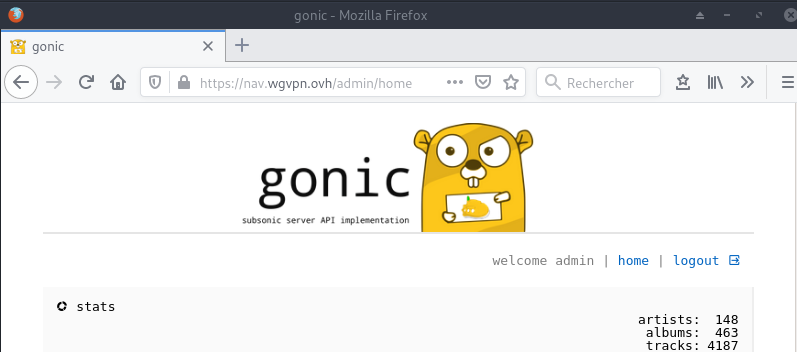
Navidrome

Applications
Calibre Web (/tech /books)
Doc technique (cinay.eu/tech)
Installer l’application Calibre-web
yunohost app install https://github.com/YunoHost-Apps/calibreweb_ynh
Choose the domain where this app should be installed [cinay.eu | div.cinay.eu | gitea.cinay.eu | static.cinay.eu | wg.cinay.eu | zic.cinay.eu | yanfi.net] (default: cinay.eu):
Choose the path where this app should be installed (default: /calibre): /tech
Choose an administrator user for this app [yann | claudine | yanfi] (default: yann):
Should this app be exposed to anonymous visitors? [yes | no] (default: no):
Select a default language [fr | en | es | de] (default: fr):
Do you want to allow uploading of books? [yes | no] (default: no):
Do you want to allow access to the library to all Yunohost users? [yes | no] (default: yes):
[...]
Success! Installation completed
Emplacement par défaut de la base de donnée Calibre : /home/yunohost.multimedia/share/eBook/
Ouvrir l’application https://cinay.eu/tech et basculer en administration
Editer la Configuration principale , modifier le dossier bibliothèque /opt/sshfs/CalibreTechnique

Changer le nom de l’application calibre-web
yunohost app change-label calibreweb 'Documentation Technique'
Accès documentation technique https://cinay.eu/tech
Livres et romans (cinay.eu/books)
Installer l’application Calibre-web
yunohost app install https://github.com/YunoHost-Apps/calibreweb_ynh
[...]
Choose a path for Calibre-web (default: /calibre): /books
[...]
Success! Installation completed
Emplacement par défaut de la base de donnée Calibre : /home/yunohost.multimedia/share/eBook/
Ouvrir l’application https://cinay.eu/books et basculer en administration
Editer la Configuration principale , dossier bibliothèque : /opt/sshfs/BiblioCalibre
Changer le nom de l’application calibre-web
yunohost app change-label calibreweb__2 'Livres et romans'
Accès documentation ‘Livres et romans’ https://cinay.eu/books
Shaarli (cinay.eu/shaarli)

Shaarli est un logiciel libre permettant de sauvegarder, trier, synchroniser et partager des adresses web.
Installation
yunohost app install shaarli
Available domains:
- cinay.eu
- wg.cinay.eu
- zic.cinay.eu
- searx.cinay.eu
Choose a domain for your Shaarli (default: cinay.eu):
Choose a path for your Shaarli (default: /shaarli):
Is it a public Shaarli site ? [yes | no] (default: no): yes
Info: Installing the app 'shaarli'…
Info: Validating installation parameters...
Info: Storing installation settings...
Info: Installing dependencies...
Info: Setting up source files...
Info: Configuring nginx web server...
Info: Configuring system user...
Info: Configuring php-fpm...
Info: Configuring log rotation...
Info: Set permissions...
Info: Set rights...
Warning: Too many arguments ! "1" will be ignored.
Info: Add Fail2Ban configuration...
Warning: Too many arguments ! "1" will be ignored.
Info: Configuring SSOwat...
Warning: /!\ Packagers! This app is still using the skipped/protected/unprotected_uris/regex settings which are now obsolete and deprecated... Instead, you should use the new helpers 'ynh_permission_{create,urls,update,delete}' and the 'visitors' group to initialize the public/private access. Check out the documentation at the bottom of yunohost.org/groups_and_permissions to learn how to use the new permission mechanism.
Info: Reloading nginx web server...
Info: Installation of shaarli completed
Success! Installation completed
liens publiques cinay.eu/shaarli https://cinay.eu/shaarli/?do=tagcloud
Ajout signet (cinay.eu/shaarli)
javascript:(function(){
var%20url%20=%20location.href;
var%20title%20=%20document.title%20||%20url;
var%20desc=document.getSelection().toString();
if(desc.length>4000){
desc=desc.substr(0,4000)+'...';
alert('Le%20texte%20s%C3%A9lectionn%C3%A9%20est%20trop%20long,%20il%20sera%20tronqu%C3%A9.');
}
window.open('https://cinay.eu/shaarli/?post='%20+%20encodeURIComponent(url)+ '&title='%20+%20encodeURIComponent(title)+ '&description='%20+%20encodeURIComponent(desc)+ '&source=bookmarklet','_blank','menubar=no,height=800,width=600,toolbar=no,scrollbars=yes,status=no,dialog=1');
})();
Tiny Tiny RSS (/ttrss)

Tiny Tiny RSS (ttrss) est un agrégateur de flux RSS et Atom libre sous licence libre GNU GPL v3
Installation en mode de commande (su)
yunohost app install ttrss
Available domains:
- cinay.eu
- yanfi.net
- wg.cinay.eu
- zic.cinay.eu
- searx.cinay.eu
Choose a domain for Tiny-Tiny-RSS (default: cinay.eu):
Choose a path for Tiny-Tiny-RSS (default: /ttrss):
Info: Installing the app 'ttrss'…
Info: [....................] > Validating installation parameters...
Info: [+...................] > Storing installation settings...
Info: [#++++...............] > Installing dependencies...
Info: [#####+..............] > Creating a MySQL database...
Info: [######++++..........] > Setting up source files...
Info: [##########..........] > Configuring nginx web server...
Info: [##########+.........] > Configuring system user...
Info: [###########+........] > Configuring php-fpm...
Info: [############+.......] > Configuring ttrss...
Info: [#############+......] > Configuring a systemd service...
Info: [##############+++...] > Initializing database...
Info: [#################...] > Starting ttrss...
Info: [#################+..] > Configuring SSOwat...
Warning: /!\ Packagers! This app is still using the skipped/protected/unprotected_uris/regex settings which are now obsolete and deprecated... Instead, you should use the new helpers 'ynh_permission_{create,urls,update,delete}' and the 'visitors' group to initialize the public/private access. Check out the documentation at the bottom of yunohost.org/groups_and_permissions to learn how to use the new permission mechanism.
Info: [##################+.] > Reloading nginx web server...
Success! Installation completed
Mise à jour
yunohost app upgrade ttrss -u https://github.com/YunoHost-Apps/ttrss_ynh/tree/testing --debug
Nextcloud (/nextcloud)

Installation
en ligne de commande
yunohost app install nextcloud
Available domains:
- cinay.eu
- yanfi.net
- wg.cinay.eu
- zic.cinay.eu
- searx.cinay.eu
Choose a domain for Nextcloud (default: cinay.eu):
Choose a path for Nextcloud (default: /nextcloud):
Available users:
- yann
- claudine
- yanfi
Choose the Nextcloud administrator (must be an existing YunoHost user): yann
Access the users home folder from Nextcloud? [yes | no] (default: no): yes
Info: Installing the app 'nextcloud'…
Info: [....................] > Validating installation parameters...
Info: [....................] > Storing installation settings...
Info: [+...................] > Installing dependencies...
Warning:
Warning: Creating config file /etc/samba/smb.conf with new version
Warning: Created symlink /etc/systemd/system/multi-user.target.wants/atd.service -> /lib/systemd/system/atd.service.
Warning: Load smb config files from /etc/samba/smb.conf
Warning: Loaded services file OK.
Warning: Server role: ROLE_STANDALONE
Warning:
Info: [#+..................] > Creating a MySQL database...
Info: [##..................] > Setting up source files...
Info: [##..................] > Configuring nginx web server...
Info: [##+.................] > Configuring system user...
Info: [###++++++++.........] > Configuring php-fpm...
Warning:
Warning: Creating config file /etc/php/7.3/mods-available/bz2.ini with new version
Warning:
Warning: Creating config file /etc/php/7.3/mods-available/gmp.ini with new version
Warning:
Warning: Creating config file /etc/php/7.3/mods-available/zip.ini with new version
Warning:
Warning: Creating config file /etc/php/7.3/mods-available/imap.ini with new version
Info: [###########++++.....] > Installing nextcloud...
Info: [###############++...] > Configuring nextcloud...
Warning: warning: commands will be executed using /bin/sh
Warning: job 1 at Tue Jul 21 16:00:00 2020
Warning: 2020-07-21 15:51:00 URL:https://codeload.github.com/YunoHost-Apps/yunohost.multimedia/tar.gz/v1.2 [15921] -> "v1.2.tar.gz" [1]
Info: [#################+..] > Adding multimedia directories...
Info: [##################..] > Configuring log rotation...
Info: [##################+.] > Configuring fail2ban...
Info: The service fail2ban has correctly executed the action reload-or-restart.
Info: [###################.] > Configuring SSOwat...
Warning: /!\ Packagers! This app is still using the skipped/protected/unprotected_uris/regex settings which are now obsolete and deprecated... Instead, you should use the new helpers 'ynh_permission_{create,urls,update,delete}' and the 'visitors' group to initialize the public/private access. Check out the documentation at the bottom of yunohost.org/groups_and_permissions to learn how to use the new permission mechanism.
Warning: /!\ Packagers! This app is still using the skipped/protected/unprotected_uris/regex settings which are now obsolete and deprecated... Instead, you should use the new helpers 'ynh_permission_{create,urls,update,delete}' and the 'visitors' group to initialize the public/private access. Check out the documentation at the bottom of yunohost.org/groups_and_permissions to learn how to use the new permission mechanism.
Info: [###################.] > Reloading nginx web server...
Success! Installation completed
Dans les paramètres fichier de nextcloud , activer l’affichage des fichiers masqués
Activer les applications
Activer les applications Calendar, Contacts et Notes sur nextcloud
Calendrier et contacts (android et thunderbird)
Paramétrage OpenSync android
Connexion avec le lien https://cinay.eu/nextcloud/remote.php/dav (login+mdp)
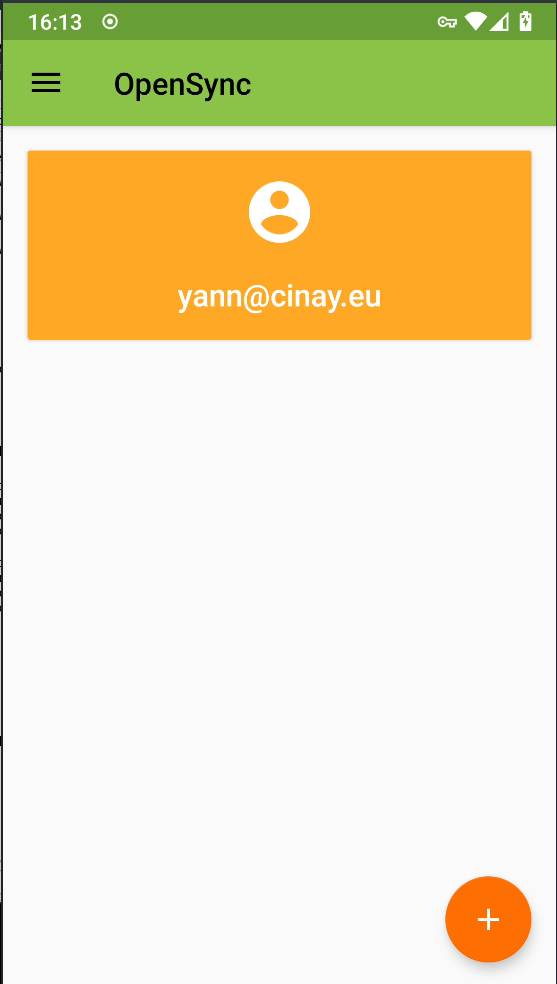

Paramétrer les applications qui utilisent le calendrier et les contacts
Contacts , acalendar et Tâches

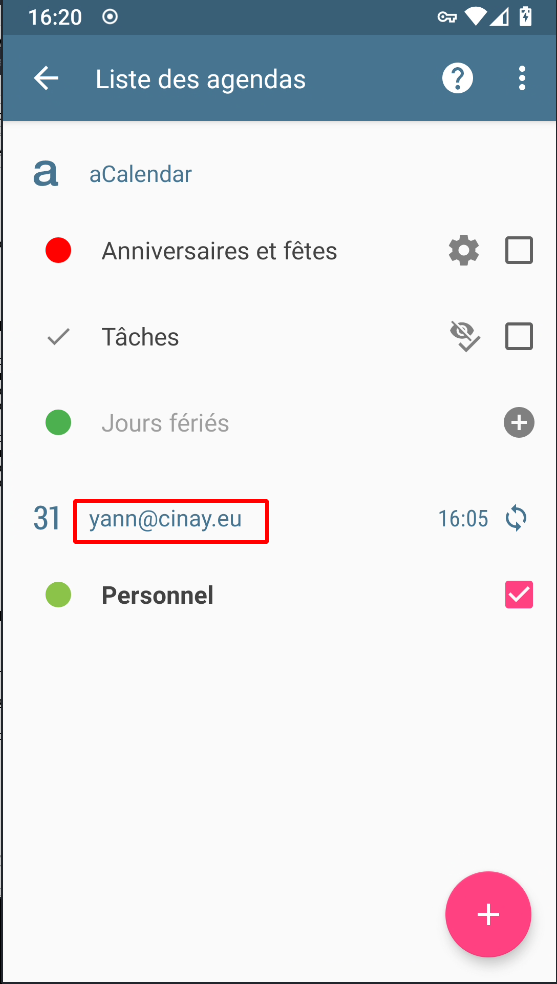

Paramétrage agenda Thunderbird
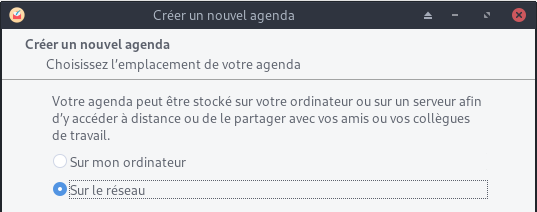

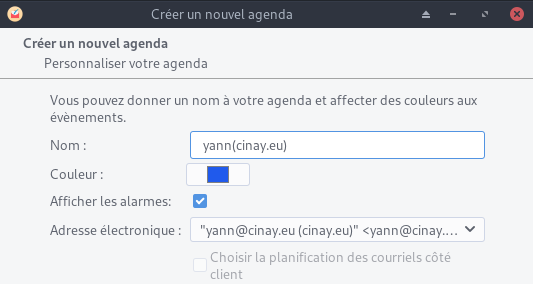


Se désabonner de l’ancien agenda cinay.xyz
Paramétrage contacts Thunderbird
Outils → Préférences des modules → TbSync
Dans l’application
Actions sur les comptes → Ajouter un nouveau compte → Caldav & Carddav

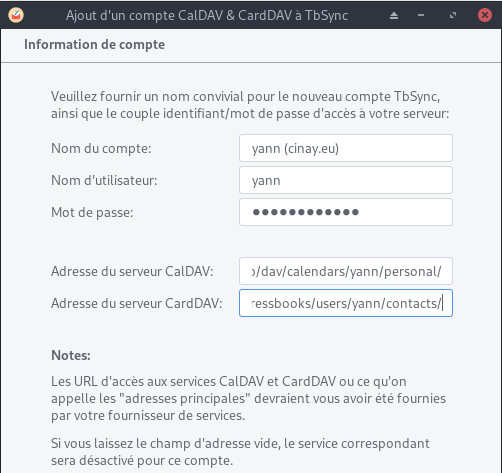
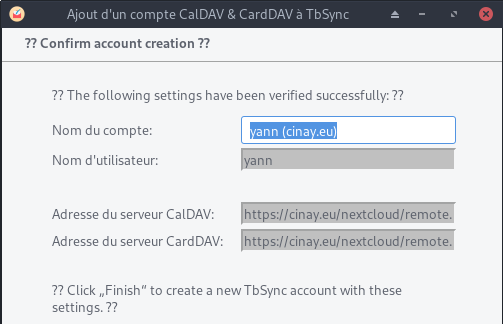
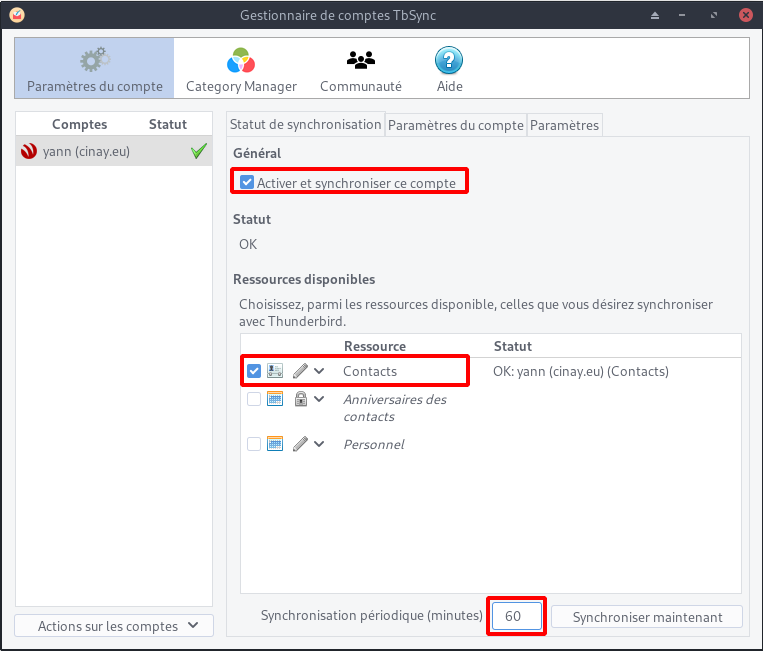
Synchronisation toutes les heures pour les contacts
Liens caldav carddav sur thunderbird (yann)
https://cinay.eu/nextcloud/remote.php/dav/calendars/yann/personal/
https://cinay.eu/nextcloud/remote.php/dav/addressbooks/users/yann/contacts/
Compte nextcloud sur les postes clients de type PC
Ajout du compte https://cinay.eu/nextcloud sur les clients nextcloud
Synchronisations:
- ~/.keepassx → Home/.keepassx (créer le dossier)
- ~/media/Notes → Notes (créer le dossier)
Compte nextcloud sur android
Application nextcloud installée
Se connecter https://cinay.eu/nextcloud et vérifier la création du compte
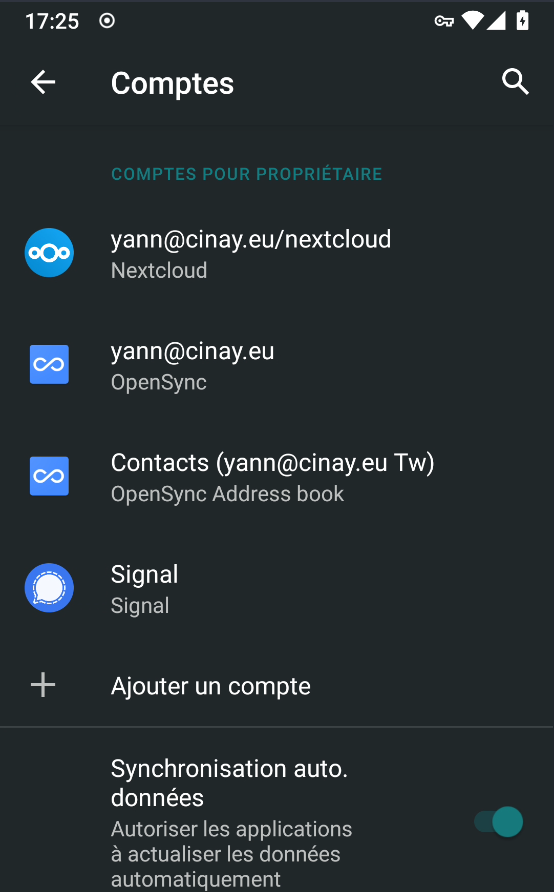
Synchroniser le fichier de mot de passe avec l’application keepass

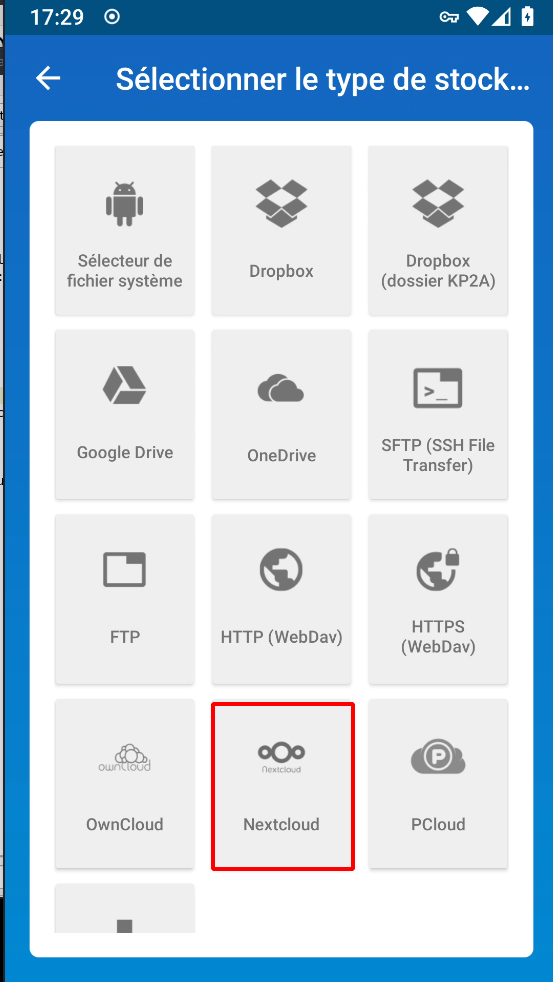
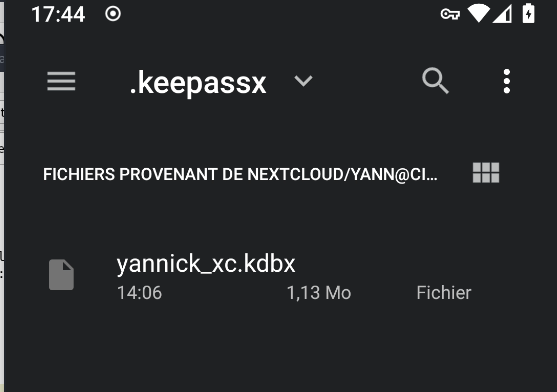
Gitea (gitea.cinay.eu)

Ajout domaine et certificats gitea.cinay.eu
yunohost domain add gitea.cinay.eu
yunohost domain cert-install gitea.cinay.eu --no-checks
Installation à partir de github, on clône le dépôt
git clone https://github.com/YunoHost-Apps/gitea_ynh.git
Blocage sur fail2ban à l’installation
Commenter la mise en place FAIL2BAN
nano gitea_ynh/scripts/install
# SETUP FAIL2BAN
#ynh_script_progression --message="Configuring fail2ban..."
#ynh_add_fail2ban_config --logpath "/var/log/$app/gitea.log" --failregex ".*Failed authentication attempt for .* from <HOST>" --max_retry 5
Installer gitea
yunohost app install gitea_ynh
Fail2ban , règle qui n’est pas ajouté
ynh_add_fail2ban_config --logpath /var/log/gitea/gitea.log --failregex '.*Failed authentication attempt for .* from <HOST>' --max_retry 5
Probème de mise à jour
yunohost app upgrade gitea -u https://github.com/YunoHost-Apps/gitea_ynh
Warning: Reload the service fail2ban
Warning: ............................................................................................................................................................................................................................................................................................................The service fail2ban didn't fully started before the timeout.
Warning: -- Logs begin at Thu 2020-10-08 17:30:01 CEST, end at Fri 2020-10-09 11:17:21 CEST. --
Warning: Oct 09 10:21:56 cinay.eu fail2ban-client[26484]: OK
Warning: Oct 09 10:21:56 cinay.eu systemd[1]: Reloaded Fail2Ban Service.
Warning: Oct 09 10:28:15 cinay.eu systemd[1]: Reloading Fail2Ban Service.
Warning: Oct 09 10:28:15 cinay.eu fail2ban-client[27234]: OK
Warning: Oct 09 10:28:15 cinay.eu systemd[1]: Reloaded Fail2Ban Service.
Warning: Oct 09 10:52:39 cinay.eu systemd[1]: /lib/systemd/system/fail2ban.service:12: PIDFile= references path below legacy directory /var/run/, updating /var/run/fail2ban/fail2ban.pid → /run/fail2ban/fail2ban.pid; please update the unit file accordingly.
Warning: Oct 09 10:52:40 cinay.eu systemd[1]: /lib/systemd/system/fail2ban.service:12: PIDFile= references path below legacy directory /var/run/, updating /var/run/fail2ban/fail2ban.pid → /run/fail2ban/fail2ban.pid; please update the unit file accordingly.
Warning: Oct 09 10:52:57 cinay.eu systemd[1]: Reloading Fail2Ban Service.
Warning: Oct 09 10:52:57 cinay.eu fail2ban-client[32448]: OK
Warning: Oct 09 10:52:57 cinay.eu systemd[1]: Reloaded Fail2Ban Service.
Warning: Oct 09 10:57:21 cinay.eu systemd[1]: /lib/systemd/system/fail2ban.service:12: PIDFile= references path below legacy directory /var/run/, updating /var/run/fail2ban/fail2ban.pid → /run/fail2ban/fail2ban.pid; please update the unit file accordingly.
Warning: Oct 09 10:57:22 cinay.eu systemd[1]: /lib/systemd/system/fail2ban.service:12: PIDFile= references path below legacy directory /var/run/, updating /var/run/fail2ban/fail2ban.pid → /run/fail2ban/fail2ban.pid; please update the unit file accordingly.
Warning: Oct 09 10:57:36 cinay.eu systemd[1]: Reloading Fail2Ban Service.
Warning: Oct 09 10:57:36 cinay.eu fail2ban-client[5219]: OK
Warning: Oct 09 10:57:36 cinay.eu systemd[1]: Reloaded Fail2Ban Service.
Warning: Oct 09 11:12:33 cinay.eu systemd[1]: /lib/systemd/system/fail2ban.service:12: PIDFile= references path below legacy directory /var/run/, updating /var/run/fail2ban/fail2ban.pid → /run/fail2ban/fail2ban.pid; please update the unit file accordingly.
Warning: Oct 09 11:12:33 cinay.eu systemd[1]: /lib/systemd/system/fail2ban.service:12: PIDFile= references path below legacy directory /var/run/, updating /var/run/fail2ban/fail2ban.pid → /run/fail2ban/fail2ban.pid; please update the unit file accordingly.
Warning: Oct 09 11:12:48 cinay.eu systemd[1]: Reloading Fail2Ban Service.
Warning: Oct 09 11:12:48 cinay.eu fail2ban-client[10435]: OK
Warning: Oct 09 11:12:48 cinay.eu systemd[1]: Reloaded Fail2Ban Service.
Info: [###############.....] > Update permission...
Warning: Group 'visitors' already has permission 'gitea.main' enabled
Warning: This permission is currently granted to all users in addition to other groups. You probably want to either remove the 'all_users' permission or remove the other groups it is currently granted to.
Warning: The permission was not updated because the addition/removal requests already match the current state.
Warning: /usr/share/yunohost/helpers.d/utils: line 583: manifest: unbound variable
Info: [###############+....] > Protecting directory
Info: [################+...] > Configuring permissions...
Warning: Group 'visitors' already has permission 'gitea.main' enabled
Warning: This permission is currently granted to all users in addition to other groups. You probably want to either remove the 'all_users' permission or remove the other groups it is currently granted to.
Warning: The permission was not updated because the addition/removal requests already match the current state.
Warning: Start the service gitea
Info: [#################++.] > Starting gitea services...
Warning: ..The service gitea has correctly started.
sh: 0: getcwd() failed: No such file or directory
sh: 0: getcwd() failed: No such file or directory
Success! gitea upgraded
sh: 0: getcwd() failed: No such file or directory
sh: 0: getcwd() failed: No such file or directory
sh: 0: getcwd() failed: No such file or directory
Success! Upgrade complete
Redémarrer fail2ban
systemctl restart fail2ban
journalctl --unit=fail2ban
Oct 09 11:27:39 cinay.eu systemd[1]: Stopping Fail2Ban Service...
Oct 09 11:27:40 cinay.eu fail2ban-client[12316]: Shutdown successful
Oct 09 11:27:40 cinay.eu systemd[1]: fail2ban.service: Main process exited, code=killed, status=15/TERM
Oct 09 11:27:40 cinay.eu systemd[1]: fail2ban.service: Succeeded.
Oct 09 11:27:40 cinay.eu systemd[1]: Stopped Fail2Ban Service.
Oct 09 11:27:40 cinay.eu systemd[1]: Starting Fail2Ban Service...
Oct 09 11:27:40 cinay.eu systemd[1]: Started Fail2Ban Service.
Oct 09 11:27:40 cinay.eu fail2ban-server[12320]: Server ready
static.cinay.eu
En mode su
Créer le domaine static.cinay.eu et les certificats
yunohost domain add static.cinay.eu
yunohost domain cert-install static.cinay.eu --no-checks
Installer l’application Multi web app sur le domaine static.cinay.eu
git clone https://gitea.cinay.eu/yann/multi_webapp_buster_ynh
yunohost app install https://gitea.cinay.eu/yann/multi_webapp_buster_ynh
DANGER! This app is not part of Yunohost's app catalog. Installing third-party apps may compromise the integrity and security of your system. You should probably NOT install it unless you know what you are doing. NO SUPPORT will be provided if this app doesn't work or breaks your system… If you are willing to take that risk anyway, type 'Yes, I understand': Yes, I understand
Available domains:
- cinay.eu
- yanfi.net
- wg.cinay.eu
- zic.cinay.eu
- static.cinay.eu
- gitea.cinay.eu
- searx.cinay.eu
Choose a domain for your Webapp (default: cinay.eu): static.cinay.eu
Choose a path for your Webapp (default: /site): /
Available users:
- yann
- claudine
- yanfi
Choose the YunoHost user: yann
Create a database? [yes | no] (default: no):
Is it a public website ? [yes | no] (default: no): yes
Success! Installation completed
multi_webapp__3 (static.cinay.eu) à un accès complet sans aucune autorisation
Le dossier /opt/yann/static/ contient le site statique qui est issu d’une synchronisation d’un conteneur debian sur un ordinateur archlinux avec jekyll comme générateur
rm -r /var/www/webapp_yann/static.cinay.eu_ # supprimer dossier web
ln -s /opt/yann/static /var/www/webapp_yann/static.cinay.eu_ # lien
Modifier l’étiquette multi_webapp__3 (static.cinay.eu)
yunohost app change-label multi_webapp__3 'Statique static.cinay.eu'
div.cinay.eu
En mode su
Créer le domaine div.cinay.eu et les certificats
yunohost domain add div.cinay.eu
yunohost domain cert-install div.cinay.eu --no-checks
Installer l’application Multi web app sur le domaine div.cinay.eu
yunohost app install https://gitea.cinay.eu/yann/multi_webapp_buster_ynh
[...]
Choose a domain for your Webapp (default: cinay.eu): div.cinay.eu
Choose a path for your Webapp (default: /site): /
Available users:
- yann
- claudine
- yanfi
Choose the YunoHost user: yann
Create a database? [yes | no] (default: no):
Is it a public website ? [yes | no] (default: no): yes
Success! Installation completed
Modifier l’étiquette multi_webapp__4
yunohost app change-label multi_webapp__4 'div.cinay.eu'
Le dossier correspondant : /var/www/webapp_yann/div.cinay.eu_/
Créer des liens
sudo ln -s /opt/sshfs/diceware /var/www/webapp_yann/div.cinay.eu_/diceware
sudo ln -s /opt/sshfs/osm-new /var/www/webapp_yann/div.cinay.eu_/osm-new
sudo ln -s /opt/sshfs/htmldoc /var/www/webapp_yann/div.cinay.eu_/htmldoc
Le site
ls -la /var/www/webapp_yann/div.cinay.eu_/
total 24
drwxrwxr-x 4 yann webapp_div.cinay.eu_ 4096 Sep 23 15:55 .
drwxr-xr-x 5 root root 4096 Sep 23 12:02 ..
drwxr-xr-x 6 debian debian 4096 Jun 6 2019 assets
lrwxrwxrwx 1 root root 19 Sep 23 15:55 diceware -> /opt/sshfs/diceware
drwxr-xr-x 4 debian debian 4096 Sep 23 14:17 images
-rw-r--r-- 1 debian debian 6922 Sep 23 15:49 index.html
lrwxrwxrwx 1 root root 18 Sep 23 15:55 osm-new -> /opt/sshfs/osm-new
cinay.eu/site (cartes)
Installer l’application Multi web app
yunohost app install https://gitea.cinay.eu/yann/multi_webapp_buster_ynh
[...]
Choose the domain where this app should be installed [cinay.eu | div.cinay.eu | gitea.cinay.eu | static.cinay.eu | wg.cinay.eu | zic.cinay.eu | yanfi.net] (default: cinay.eu):
Choose the path where this app should be installed (default: /site):
Choose an administrator user for this app [yann | claudine | yanfi] (default: yann):
Create a database? [yes | no] (default: no):
Should this app be exposed to anonymous visitors? [yes | no] (default: no): yes
[...]
Success! Installation completed
Modifier l’étiquette multi_webapp__5
yunohost app change-label multi_webapp__5 '/site Cartes '
Le dossier correspondant : /var/www/webapp_yann/cinay.eu_site/
Le lien
sudo rm -r /var/www/webapp_yann/cinay.eu_site
sudo ln -s /opt/sshfs/osm-new /var/www/webapp_yann/cinay.eu_site
Sauvegardes
yunohost
Création d’une sauvegarde complète yunohost
sudo -s
yunohost backup create -n Backup-Yunohost-cinay.eu
Sauvegarde automatique tous les jours
sudo -s
crontab -e
# Sauvegarde yunohost
00 02 * * * /usr/bin/rm /home/yunohost.backup/archives/* && /usr/bin/yunohost backup create -n Backup-Yunohost-cinay.eu > /dev/null
BorgBackup

Préparation de la machine à sauvegarder
On se connecte sur la machine et on passe en mode su
sudo -s
apt update
Installer borgbackup
apt install borgbackup
Créer un jeu de clé sur machine à sauvegarder (cinay.eu)
Créer un utilisateur borg (sans home) dédié aux sauvegardes par BorgBackup :
useradd -M borg
Générer un jeu de clé sur /root/.ssh
mkdir -p /root/.ssh
ssh-keygen -t ed25519 -o -a 100 -f /root/.ssh/cinay.eu_ed25519
Le jeu de clé
ls /root/.ssh
cinay.eu_ed25519 cinay.eu_ed25519.pub
Autoriser utilisateur borg à exécuter /usr/bin/borg uniquement
echo "borg ALL=NOPASSWD: /usr/bin/borg" >> /etc/sudoers
Ajout clé publique au serveur backup xoyaz.xyz
Pour une connexion via ssh vous devez ajouter la clé publique cinay.eu_ed25519.pub du serveur client cinay.eu au fichier ~/.ssh/authorized_keys du serveur backup xoyaz.xyz
Se connecter au serveur backup xoyaz.xyz depuis un terminal autorisé
ssh usernl@5.2.79.107 -p 55036 -i /home/yannick/.ssh/OVZ-STORAGE-128 # connexion SSH serveur backup depuis PC1
sudo -s # passer en super utilisateur
cat >> /srv/data/borg-backups/.ssh/authorized_keys
Copier/coller le contenu du fichier du fichier de clef publique (fichier /root/.ssh/cinay.eu_ed25519.pub de la machine à sauvegarder cinay.eu ) dans ce terminal, et presser [Ctrl]+[D] pour valider.
Test depuis le serveur client cinay.eu (c’est lui qui possède la clé privée).
Si parefeu avec les sorties bloquées sur cinay.eu , il faut ouvrir en sortie le port TCP 55036.
AU PREMIER passage une question est posée , saisir oui ou yes
sudo -s
ssh -p 55036 -i /root/.ssh/cinay.eu_ed25519 borg@xoyaz.xyz
The authenticity of host '[xoyaz.xyz]:55036 ([2a04:52c0:101:7ae::7a5e]:55036)' can't be established.
ECDSA key fingerprint is SHA256:PDXQBhTh4oj0cSzgnjCun+J60JDUEk7VeLH2YHZbwMc.
Are you sure you want to continue connecting (yes/no)? yes
hosts.
Linux vps70253415 4.19.0-9-amd64 #1 SMP Debian 4.19.118-2+deb10u1 (2020-06-07) x86_64
____ __ ___ ___ ____ _ _ _ ___
__ __ _ __ ___|__ |/ \|_ )| __||__ /| | | / || __|
\ V /| '_ \(_-< / /| () |/ / |__ \ |_ \|_ _|| ||__ \
\_/ | .__//__/ /_/ \__//___||___/|___/ |_| |_||___/
__|_| ___ ____ ___ _ ___ ____
| __| |_ ) |__ |/ _ \ / ||_ )|__ |
|__ \ _ / / _ / / \_, /_ | | / / / /
|___/(_)/___|(_)/_/ /_/(_)|_|/___| /_/
Last login: Wed Jun 10 15:34:07 2020 from 51.91.249.57
$
saisir exit pour sortir
NOTE : /srv/data/borg-backups est le home de l’utilisateur borg sur le serveur backup xoyaz.xyz
Création dépôt et lancement des sauvegardes depuis la machine à sauvegarder
machine cliente cinay.eu
On se connecte sur la machine et on passe en mode su
sudo -s
Création du dépôt distant sur le serveur backup xoyaz.xyz (A FAIRE UNE SEULE FOIS)
export BORG_RSH='ssh -i /root/.ssh/cinay.eu_ed25519' # ce n'est pas la clé par défaut id_rsa
borg init --encryption=repokey-blake2 ssh://borg@xoyaz.xyz:55036/srv/data/borg-backups/cinay.eu
Enter new passphrase:
Enter same passphrase again:
Do you want your passphrase to be displayed for verification? [yN]:
By default repositories initialized with this version will produce security
errors if written to with an older version (up to and including Borg 1.0.8).
If you want to use these older versions, you can disable the check by running:
borg upgrade --disable-tam ssh://borg@xoyaz.xyz:55036/srv/data/borg-backups/cinay.eu
See https://borgbackup.readthedocs.io/en/stable/changes.html#pre-1-0-9-manifest-spoofing-vulnerability for details about the security implications.
IMPORTANT: you will need both KEY AND PASSPHRASE to access this repo!
Use "borg key export" to export the key, optionally in printable format.
Write down the passphrase. Store both at safe place(s).
Sauvegarder la “passphrase” dans un fichier pour une procédure automatique
mkdir -p /root/.borg
nano /root/.borg/passphrase
Générer une sauvegarde d’un dossier local vers le dépôt distant pour test (facultatif)
borg create ssh://borg@xoyize.xyz:55029/srv/ssd-two/borg-backups/cinay.eu::2019-01-11 /home/yanfi
Enter passphrase for key ssh://borg@xoyize.xyz:55029/srv/ssd-two/borg-backups/cinay.eu:
Automatiser la procédure de sauvegarde pour le client cinay.eu
script de sauvegarde (notez l’usage de borg prune pour supprimer les archives trop anciennes)
nano /root/.borg/borg-backup
#!/bin/sh
#
# Script de sauvegarde.
#
# Envoie les sauvegardes sur un serveur distant, via le programme Borg.
# Les sauvegardes sont chiffrées
#
set -e
BACKUP_DATE=`date +%Y-%m-%d-%Hh%M`
LOG_PATH=/var/log/borg-backup.log
export BORG_PASSPHRASE="`cat ~root/.borg/passphrase`"
export BORG_RSH='ssh -i /root/.ssh/cinay.eu_ed25519'
BORG_REPOSITORY=ssh://borg@xoyaz.xyz:55036/srv/data/borg-backups/cinay.eu
BORG_ARCHIVE=${BORG_REPOSITORY}::${BACKUP_DATE}
borg create \
-v --progress --stats --compression lzma,9 \
--exclude-from /root/.borg/exclusions --exclude-caches \
$BORG_ARCHIVE \
/ \
>> ${LOG_PATH} 2>&1
# Nettoyage des anciens backups
# On conserve
# - une archive par jour les 7 derniers jours,
# - une archive par semaine pour les 4 dernières semaines,
# - une archive par mois pour les 6 derniers mois.
borg prune \
-v --list --stats --keep-daily=7 --keep-weekly=4 --keep-monthly=6 \
$BORG_REPOSITORY \
>> ${LOG_PATH} 2>&1
root@cinay:/home/debian# nano /root/.borg/borg-backup
root@cinay:/home/debian# cat /root/.borg/borg-backup
#!/bin/sh
#
# Script de sauvegarde.
#
# Envoie les sauvegardes sur un serveur distant, via le programme Borg.
# Les sauvegardes sont chiffrées
#
set -e
BACKUP_DATE=`date +%Y-%m-%d-%Hh%M`
LOG_PATH=/var/log/borg-backup.log
export BORG_PASSPHRASE="`cat ~root/.borg/passphrase`"
export BORG_RSH='ssh -i /root/.ssh/cinay.eu_ed25519'
BORG_REPOSITORY=ssh://borg@xoyaz.xyz:55036/srv/data/borg-backups/cinay.eu
BORG_ARCHIVE=${BORG_REPOSITORY}::${BACKUP_DATE}
borg create \
-v --progress --stats --compression lzma,9 \
--exclude-caches --exclude-from /root/.borg/exclusions \
$BORG_ARCHIVE \
/ \
>> ${LOG_PATH} 2>&1
# Nettoyage des anciens backups
# On conserve
# - une archive par jour les 7 derniers jours,
# - une archive par semaine pour les 4 dernières semaines,
# - une archive par mois pour les 6 derniers mois.
borg prune \
-v --list --stats --keep-daily=7 --keep-weekly=4 --keep-monthly=6 \
$BORG_REPOSITORY \
>> ${LOG_PATH} 2>&1
exit 0
# Ancien backup
borg create \
-v --progress --stats --compression lzma,9 \
--exclude-from /root/.borg/exclusions --exclude-caches \
$BORG_ARCHIVE \
/ \
>> ${LOG_PATH} 2>&1
Le rendre exécutable
chmod +x /root/.borg/borg-backup
Fichier /root/.borg/exclusions pour ne pas sauvegarder, entre autre,le point de montage ssfs “music” (si existant)
nano /root/.borg/exclusions
/dev
/proc
/sys
/tmp
/run
/mnt
/media
lost+found
/home/yunohost.multimedia
/home/yunohost.backup
/home/yunohost.transmission
/home/yunohost.app
/opt/sshfs
Programmer la tâche à 2h40 du matin
crontab -e
# Sauvegarde sur distant avec BorgBackup
40 02 * * * /root/.borg/borg-backup > /dev/null
Tests sur le serveur
Vérifications DNS - wireguard
Les commandes suivantes ne fonctionneront que si le paquet “dnsutils” est installé sur votre système Debian!
On teste en utilisant les serveurs DNS locaux, les 3 commandes suivantes ont le même résultat
dig @127.0.0.1 afnic.fr +short +dnssec
dig @10.55.22.1 afnic.fr +short +dnssec
dig @fd87:9aa8:e67c:5a80::1 afnic.fr +short +dnssec
192.134.5.37
A 13 2 600 20200608204052 20200509084949 30435 afnic.fr. eVchVAseJD5n8W7U8okAz546Ix33hOCqRF7wLrhUV+sOTkwyXo7EwAut k/rN8wsPVpTnTpFyQLKdBTuOpx2UxA==
Propagation DNS
Messagerie
Vérification messagerie https://mecsa.jrc.ec.europa.eu/fr/
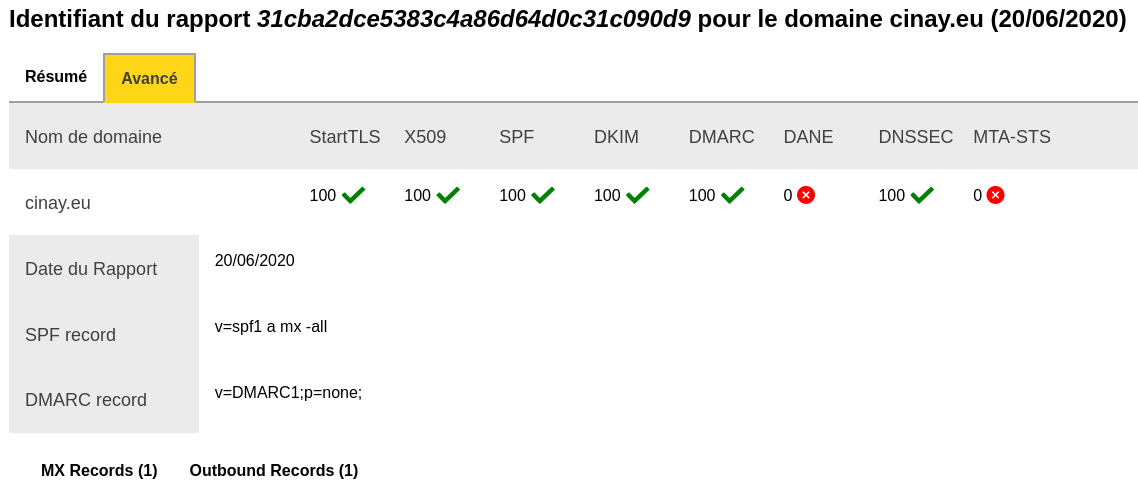
DNS blacklisting
https://www.dnsbl.info/dnsbl-database-check.php

Vulnérabilités
https://www.ssllabs.com/ssltest/analyze.html
SSL Report: cinay.eu (164.132.104.145)
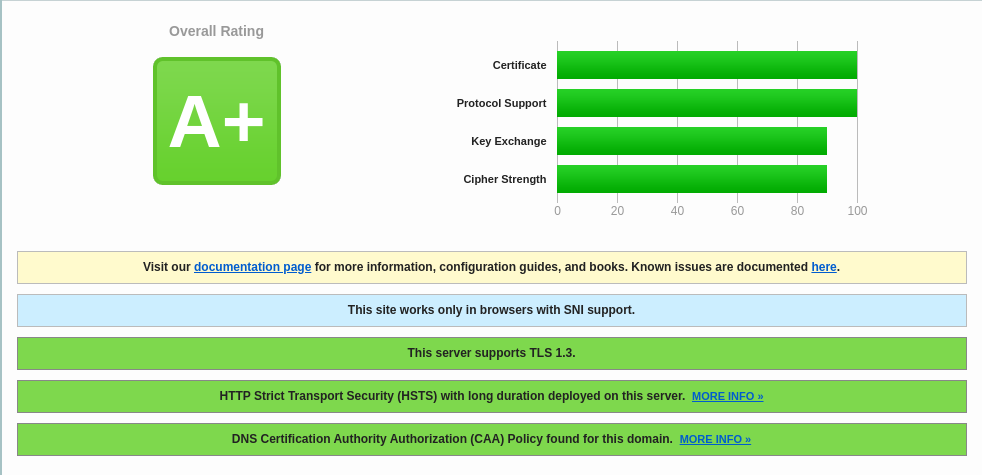
SSL Report: cinay.eu (2001:41d0:401:3200:0:0:0:6e7)
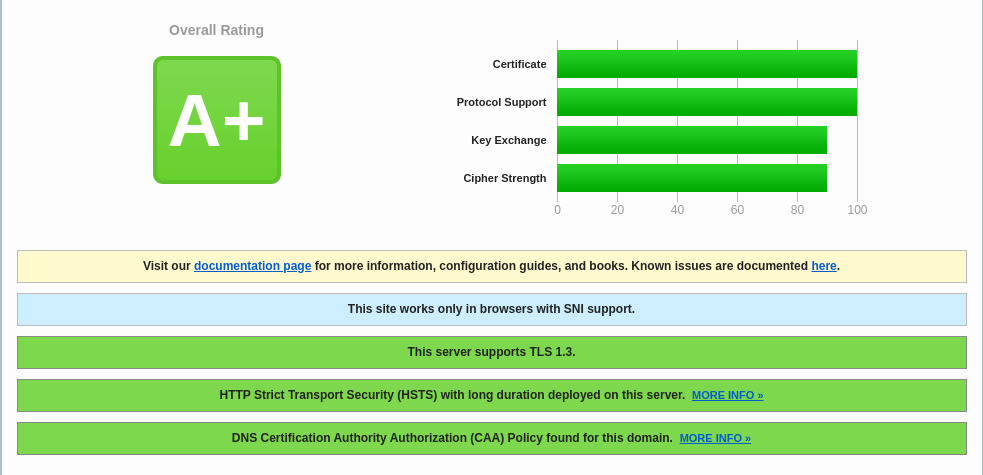
Vérifier les ports ouverts depuis un poste linux
nmap 164.132.104.145
Starting Nmap 7.70 ( https://nmap.org ) at 2020-09-25 07:34 CEST
Nmap scan report for cinay.eu (164.132.104.145)
Host is up (0.018s latency).
Not shown: 990 filtered ports
PORT STATE SERVICE
25/tcp open smtp
53/tcp open domain
80/tcp open http
443/tcp open https
587/tcp open submission
993/tcp open imaps
5222/tcp open xmpp-client
5269/tcp open xmpp-server
8083/tcp open us-srv
8084/tcp open unknown
On s’intéresse aux ports 8083 8084 , qui les utilise ?
root@cinay:/home/debian# netstat -ltnpu | grep -w '8083'
tcp 0 0 0.0.0.0:8083 0.0.0.0:* LISTEN 722/python3
tcp6 0 0 :::8083 :::* LISTEN 722/python3
root@cinay:/home/debian# ss -lptnu | grep -w '8083'
tcp LISTEN 0 128 0.0.0.0:8083 0.0.0.0:* users:(("python3",pid=722,fd=5))
tcp LISTEN 0 128 [::]:8083 [::]:* users:(("python3",pid=722,fd=7))
l affiche les sockets à l’écoute,
t affiche les connexions tcp,
u pour le protocole udp,
n permet l’affichage des adresses sous forme numérique,
p affiche les processus,
L’option -w de grep nous affiche la meilleure correspondance de la chaîne de caractères fournie.
root@cinay:/home/debian# lsof -i :8083
COMMAND PID USER FD TYPE DEVICE SIZE/OFF NODE NAME
python3 722 calibreweb 5u IPv4 23022 0t0 TCP *:8083 (LISTEN)
python3 722 calibreweb 7u IPv6 23023 0t0 TCP *:8083 (LISTEN)
root@cinay:/home/debian# lsof -i :8084
COMMAND PID USER FD TYPE DEVICE SIZE/OFF NODE NAME
python3 727 calibreweb__2 5u IPv4 23016 0t0 TCP *:8084 (LISTEN)
python3 727 calibreweb__2 7u IPv6 23017 0t0 TCP *:8084 (LISTEN)
